| Art Influence in the West | ||
Art Influence in the West
By MARY AUSTIN
Author of "A Woman of Genius," "Love and the Soul Maker," etc.
WHOEVER undertakes to discuss art influence brings up sooner or later at the Greeks. I prefer to begin there, and to begin with that one of its sources which is not peculiarly Greek, but eternal: I mean with Greece. Whatever a people may make will resemble the thing that people look on most; so that the first guess as to what is likely to come out of any quarter is a knowledge of the land itself, its keen peaks, round-breasted hills, and bloomy valleys. Greek polity had never so much to do with the surpassingness of Hellenic art as the one thing the Hellenes had nothing whatever to do with—the extraordinary beauty of the land in which they lived.
However much it is possible to derive the varied and intimate art of Italy from Greek influence, it is impossible to ignore the variations that mark just the differences between the topographies—mass, contour and color—of the two peninsulas. In attempting to forecast the probable shapes of art in any quarter of America, it becomes of prime importance to know whether the contours of that region are austere, dramatic, or slow and gracious, and, above all, whether it is colorful. Given to all quarters an equal chance at man, the richest in color will bring the quickest reactions. And of all America the most strikingly colored is the strip lying along the south Pacific coast "nearest to the terrestrial paradise," as the old Spanish romance puts it, "called Californias."
In the early days, when all the West was full of a belt-loosening, breath-easing sound as men accommodated themselves to its largeness, the color of California was a thing to make one gasp. It affronted the puritan temperament with its too abundant charm; gold it was, and blue and amber, over miles and miles of up-flung foot-hill slopes and indolent mesa. Beyond that it melted, between green and blueness, to peaks of opalescent white. It was a country of which one of the wittiest of its writers said, "You couldn't tell the truth about it without lying," and got into the blood of the Iowans and New-Englanders within a generation. It charged not only their hopes, but their speech; made it rich in figures, full of warmth and amplitude. It had even more obvious and commercial results.
On one of those frequent cross-continent trips growing out of an inability to reconcile a desire to enjoy the charm of the West with the necessity of doing business in New York, I met a buyer of women's garments for a large Los Angeles house. In the course of the acquaintance she explained why it was that my clothes, which seemed quite all right on South Occidental Boulevard, had the effect on Fifth Avenue of being noisily out of place. They were perfectly good clothes and appropriately expensive, they bunched up in the right places or displayed a modish slimness; but they put me decidedly out of the picture. The distinction was too subtle for me to grasp, but knowing nice distinctions of that kind was the buyer's business. She said it was a question of color; not so much of intensity, but of expert arrangements by which the dress of the Westerner is made to reflect the total effect of bright sun, rich-toned landscapes, and a life spent largely in the open air. The buyer expressed it more crudely than that, but she knew to a dollar in buying for Los Angeles how far she could carry the instinctive feeling of human kind for harmony with its environment.
It comes out; this lurking preference of the land for color, in that latest toy of the West, a world exposition. Whether or not they succeed in making it a bigger or a better or more interesting exposition, in one thing the West has satisfied the secret
Taking that good look at the West which is the first requisite to knowing what is to come from it, one is struck at once with the extraordinary definition of form in the landscape. The high mountain-edges deserve their specific name, Sierras—toothed, cutting edges. The foothills, even under thick chaparral, never lose their bold outlines; the pines upon the farthest ridges preserve their perfect spires; and the low, round-headed oaks, both the roble and the encina, have all been put into the landscape with the same brush. Farther south and east the buttes, squared to the sky-line, repeat the flat note of the mesas with insistence. One has, however, to turn square about, face to the Old World for a moment, to understand just what this may mean in the final product of the West. One must recall that the glory of Gothic architecture comes of its being a sublimated memory of a forest, its clustered trunks, its crossing boughs, leaf-stained light and rare chiaroscuro, and that the Egyptian expressed the massiveness of natural stony outcrops and the relief of shadowy caves from the glare of the sun. Lands which have strongly accented features from the hands of the World Builder are those which produce the lasting types of architecture, not only by the superior degree to which they stamp themselves upon the memory, but in the demands which they make for special ways of being lived in. Here in the West the suggestion made by the soil and the wild growth has already been accepted by the aboriginal. The castellated mesas have produced the flat-roofed pueblo types of dwelling, which, mixed with the elements happily introduced by the Spanish missionaries, has become one of our most characteristic styles of domestic architecture. But the peculiar gift of the Southwest to a genuine American form is the one which takes its name from the Indian bungalow on which it is remotely based. In fact, it is very little like anything in India, and has much more kinship with the American Indian wickiup both in its form and its adaptation to the exigencies of living. In other words, it is derived from the forms of life native to the land. Go up beyond Pasadena some day when the chaparral is in full leaf, and you will discover that the preferred type of dwelling repeats the characteristics of the encinal, with low, slightly pitched roofs and pillared entrances. You dive into one out of the heat and glare of the day as the rabbit into its tunnel. Southern California runs to encinal and bungalows as naturally as the North runs to sharp, sloping roofs and pointed firs. It is written in the Baedekers that the form of Milan's marble miracle was suggested by the springing stalks of marsh grasses; but it is not said anywhere often enough that if a man with the soul of an architect were brought up in the California Tulares, amid all those miles and miles of thin, graceful reeds, breaking at the top into arching, airy inflorescence, he might easily touch the inspirational sources of Milan. It is all a question of looking four hundred years forward or four hundred years back.
These two, then, must be thought of as affecting the final form of Western art—color and high simplicity of form combined with great intricacy of detail.
It is inevitable that the first response of a people to the shaping hand of beauty would be expressed in that which meets the eye, but there is another factor in life
Variations in the artistic product of any nation can be scaled very nicely to the degree to which the people live with their land rather than off it. There is much in the difference between Greek and Italian art which can be directly traced to such obvious circumstance as that the Greeks, when they were not conquering, talked philosophy, and the Romans returned to their farms to raise turnips. It is only critics of art, and not artists, who maintain that art and turnips have nothing to do with each other. For the Romans did not only plant turnips and harvest them; they understood that there is a god of turnips, an essential essence of plowed fields and dung-heaps and steaming oxen, which must all be brought into harmony by prayer and sacrifice before turnips could come forth properly to feed and comfort the nations.
Just how it works is not easy to say,—it is in part perhaps a matter of feeding,—but the great art-producing peoples have also been great agriculturists, much given to the joyous expression of their relation to the land they live in by green-corn dances, cherry-blossom fêtes, and processions to Pomona. Any one familiar with the West must see in the tendency toward rose tournaments, apple fairs, and festivals of Raisina Regina, a return to this instinctive method of dramatizing the working partnership between man and the forces of nature.
No doubt it is in part the effect of topography. Everything, even the daily alternation of night and morning, tends to appear more dramatic in a mountain country; mile-long shadows move as dials across the valleys, cloud masses do not sail an open sky, but wheel and enfilade between the ranges; storms are not obscured in a flat horizon, but are seen to gather and break, and suns come out as in an amphitheater. When I first knew that country which is watered by the Merced, Tuolumne, Kings, and Kern rivers, a country now producing food enough to support a small kingdom of Europe, it was overrun by little, long-armed Basque and French herders and their wandering flocks. It embraces in Hetch-Hetchy, Yosemite, and Kings River Cañon the most stupendous scenic panorama of America, but the herders read it as a dog reads the face of its master. I remember how in May and June they would go peering along the edge of the down-pouring rivers for the floating yellow scum, pollen drift from the forests hundreds of miles away on the uplifted flanks of the Sierras. By the date of the first appearance of the floating pollen, and the quantity, they judged whether the summer feed would be full or scanty, and on indications as slight as these they bargained with the dealers who came out from San Francisco for their spring lambs. Intimacies such as these between the land and the people breed poets faster, and much better ones, than do universities.
Undoubtedly, the development of the creative spirit in the West is affected by the sense of sustained vitality in nature. A blossoming almond-orchard is not only a beautiful thing; it is also an inescapable thing: it scents the air for almost as many miles as its delicate, roseate cloud takes the eye along the foot-hill slopes. Swarms of fallen petals drift in the roadways like snow. And the long rows of the low-trimmed muscats, reaching out from vine to vine with advancing summer as though to take hands against the weight of the harvest—how they assault us with the visible process of earth and sun and air made into wine and food for man! At every turn the consciousness of something doing, something vitally connected with the large process of nature and our own means of subsistence, raises the plane of expectation. There is something doing every minute in a country of such varied topography, as the procession of harvest follows the season. Orange-picking begins in December and overlaps the pruning of the deciduous orchards. The smoke of the last burning has scarcely passed from the shorn trees
All this makes for a kind of understanding of nature that is as different from the afternoon-walk kind of nature-loving as marrying a woman and having children by her is different from writing a sonnet to one's mistress's eyebrow. The mastery of rivers and snows and granite mountains and their conversion into crops and light and mechanical power raises the average plane of human activity all through.
It should mean that in California we shall have not necessarily poems written to a redwood and pictures of snow-capped ranges, but that whatever is written or painted should evince breadth and power. The final achievement of the people among whom this takes place ought to be a newer and more consoling expression of man's relation to the invisible, to the trend and purpose of things. In other words, one would expect the art of the West to be strongly religious in its implications. Already one sees indications of this tendency in that most native of institutions, the outdoor theater. There are enough of these delightful places of entertainment in California to be able to speak of their development as a feature of Western community life, and their evidence as to the trend of community thought is singular and convincing.
One instance of the earliest and most notable of these, the theater of the Bohemian Grove, serves our purpose better for being the best known and most unconscious. The grove, a stately recess in the redwood forest north of the bay, is the summer playground of a group of San Franciscans who are supposed to have distinguished themselves either in the creative arts or in the more personal art of living. Outside of this summer precinct they are preëminently of that stripe for whom the whole of American literature is supposed to be keyed down to the compass of a grown-up nursery-tale, the t.b.m.'s who hang around the neck of American drama like the traditional millstone to prevent its soaring to its possible and predestined heights. And every summer these tired business men, on an occasion denominated "High Jinks," produce a play which by popular deduction ought to be the concentrated extract of all the Broadway atrocities ever perpetrated in the name of entertainment. Only it isn't. It is usually poetic in form,—excellent poetry, too on more than one occasion,—it is symbolic in character, and distinctly religious in tone. That is to say that it tends to choose for its theme some aspect of man's relation to the invisible, inescapable forces of life. A year ago it was the conquest of fear in that dark region of the heart of man which once found its expression in the gargoyles of our most Christian cathedrals, the spawn of cowardice and imagination. And if the conquest of fear isn't an effort in the direction of true religion, what is it? As nearly as can be made out by report, for no woman can know any thing of them except by report, the Bohemian performances approach more nearly the Eleusinian mysteries than any modern occasion. All without conscious imitation and by the simple process of giving the Bohemians exactly what they want. It is true, however, that there are many things one can not even want in the presence of trees that might remember the drouth in the time of King Ahab, when the ravens fed Elijah.
It is not so easy to discern this native tendency behind so
stupendously mechanical a thing as a world exposition. You have to see
it not as the final expression, but as a pageant of things, the procession
around the Sabine farm in honor of the
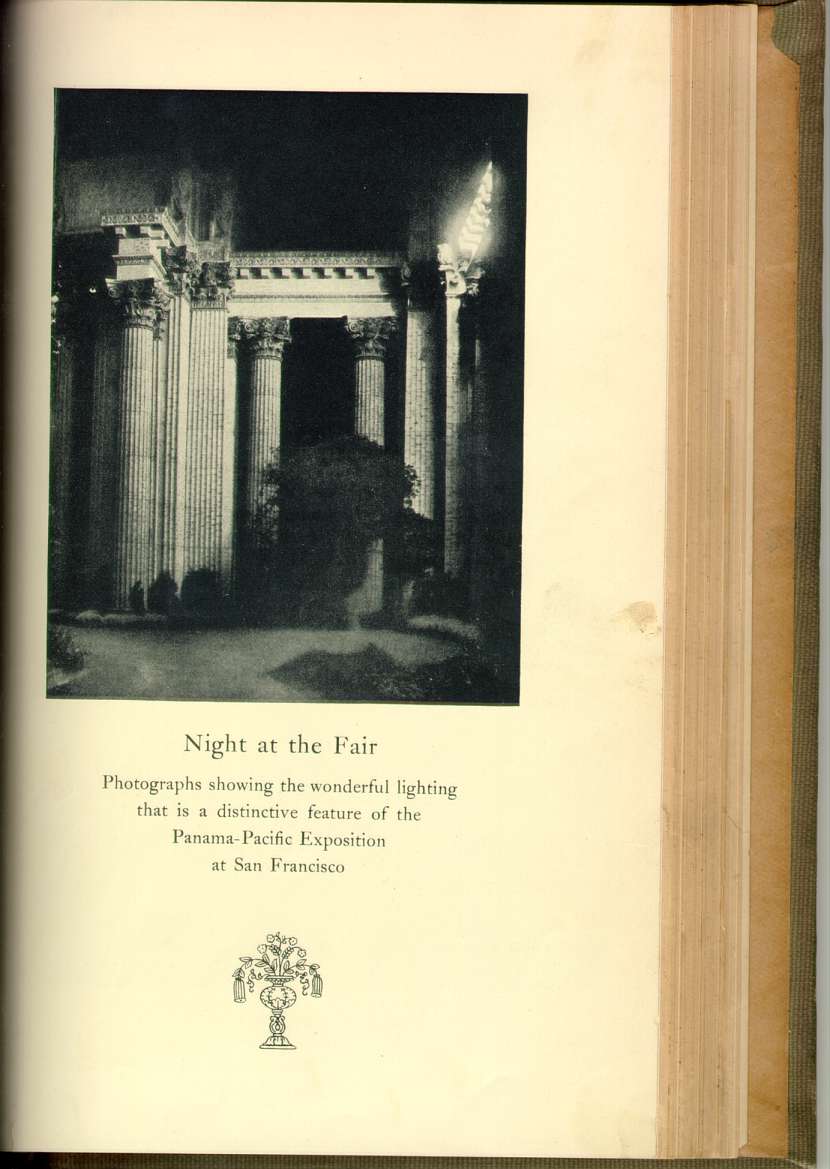
Night at the Fair
[Description: Black and white photograph taken at night of
arches at the Panama-Pacific Exposition at San Francisco]
Photographs showing the wonderful lighting
that is a distinctive feature of the Panama-Pacific Exposition at San
Francisco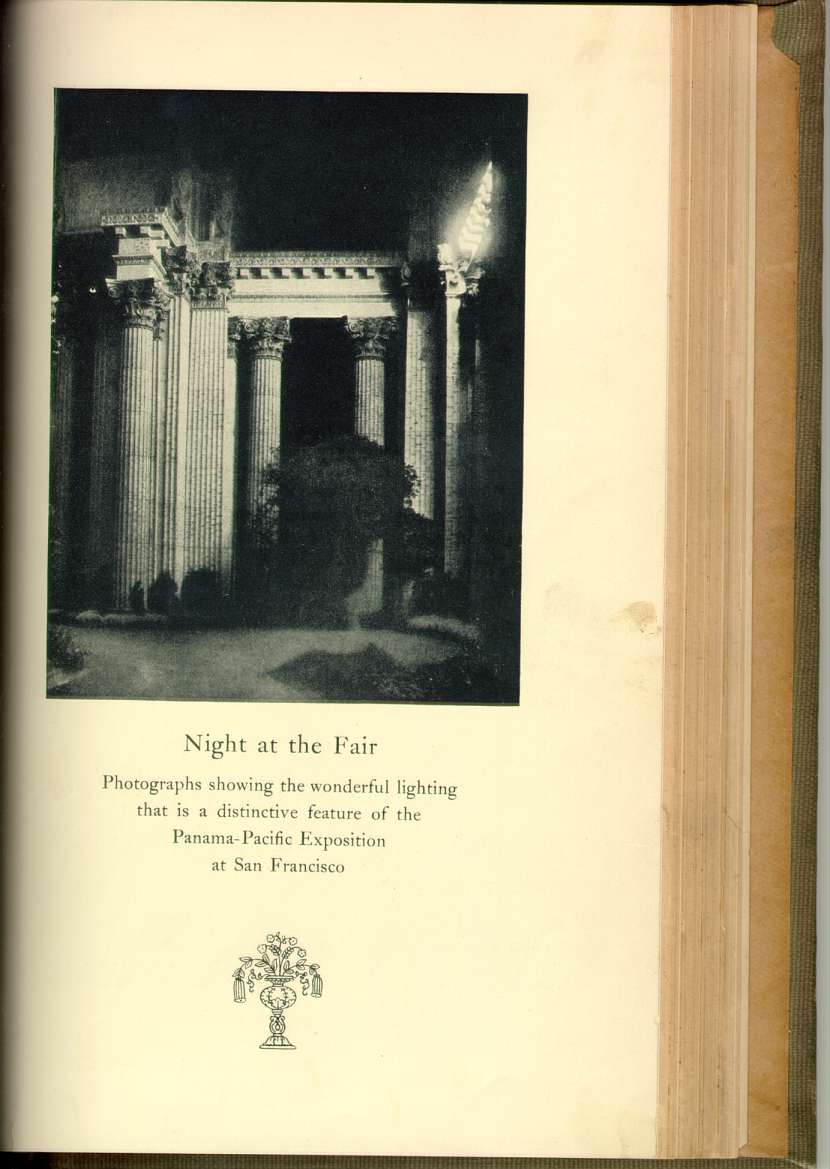 [Description: Ornamental illustration of vase and flowers]
[Description: Ornamental illustration of vase and flowers]
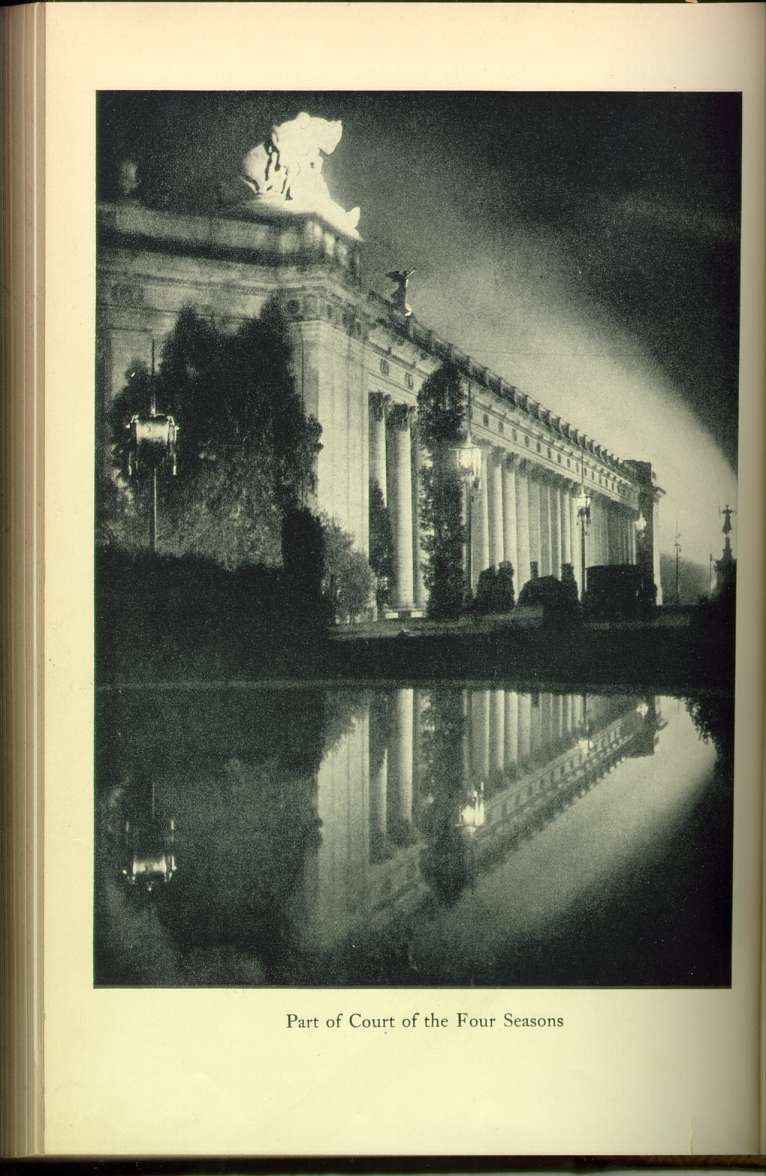
Part of Court of the Four Seasons
[Description: Black and white photograph taken at night of court of the Four
Seasons]
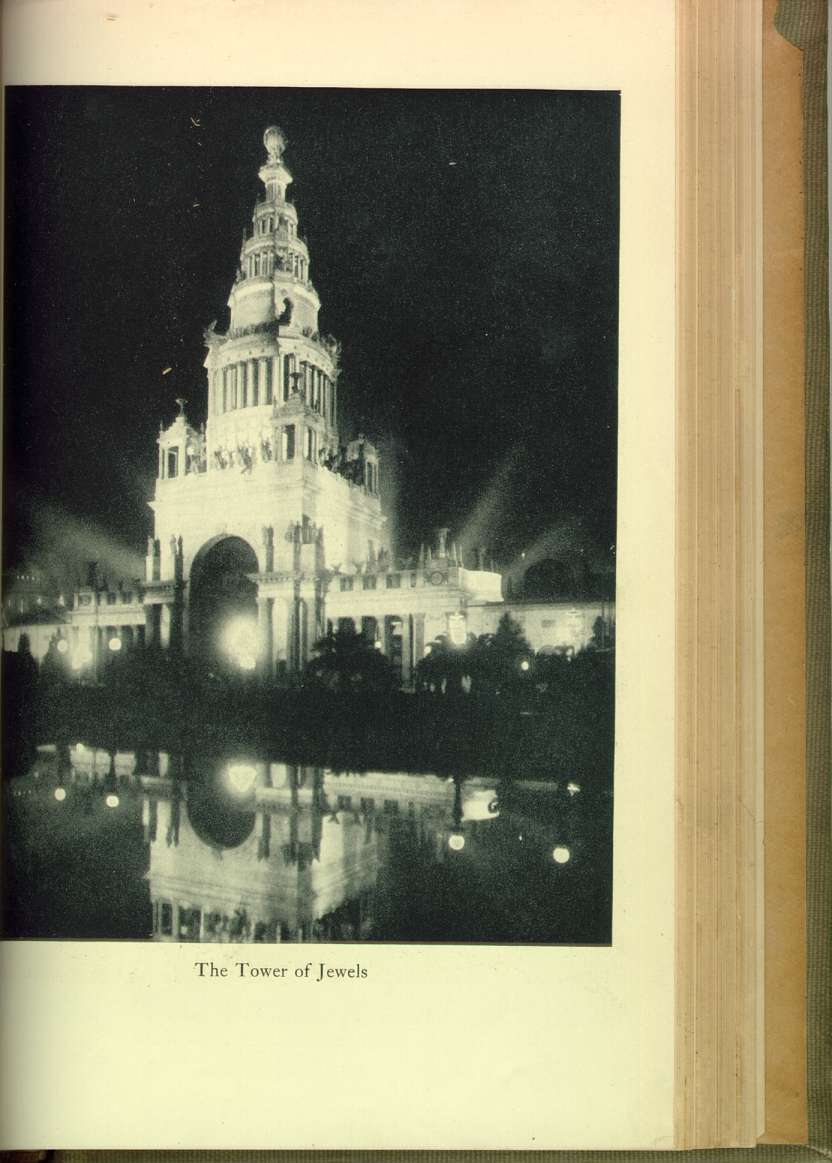
The Tower of Jewels
[Description: Black and white photograph taken at night of the Tower of
Jewels] 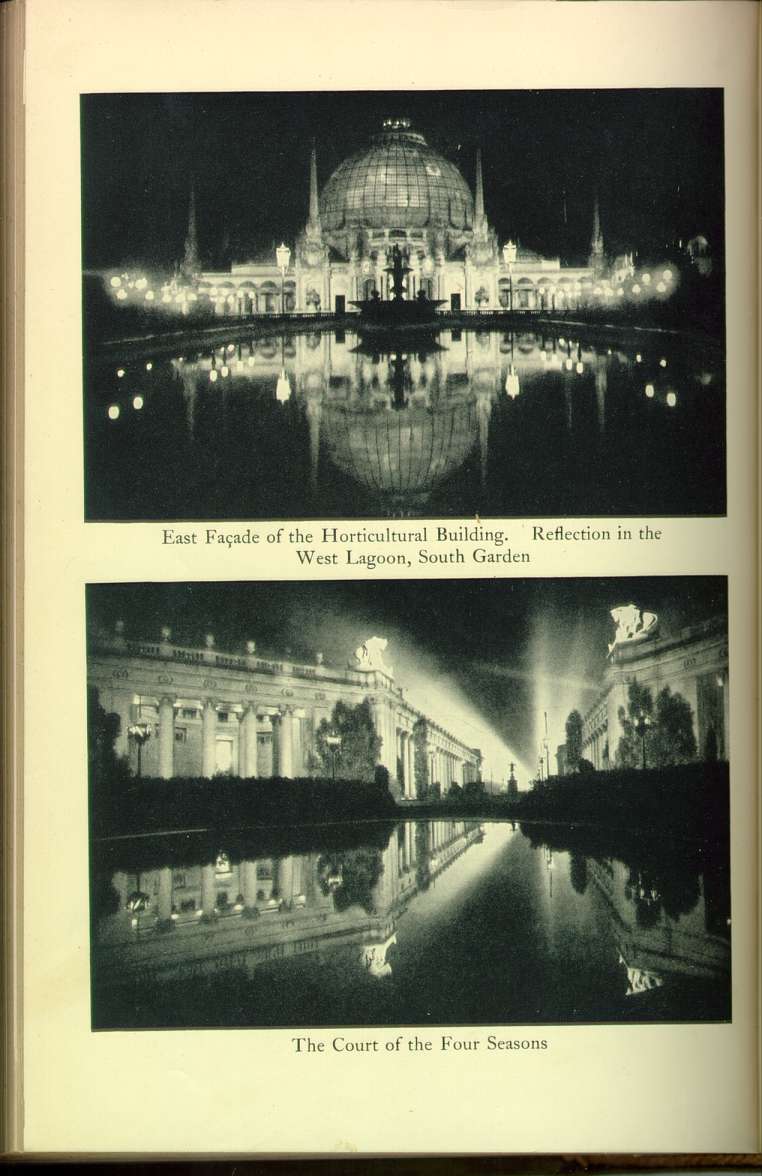
East Façade of the Horticultural Building. Reflection in
the West Lagoon, South Garden
[Description: Black and white photograph taken at night of the Horticultural
building]
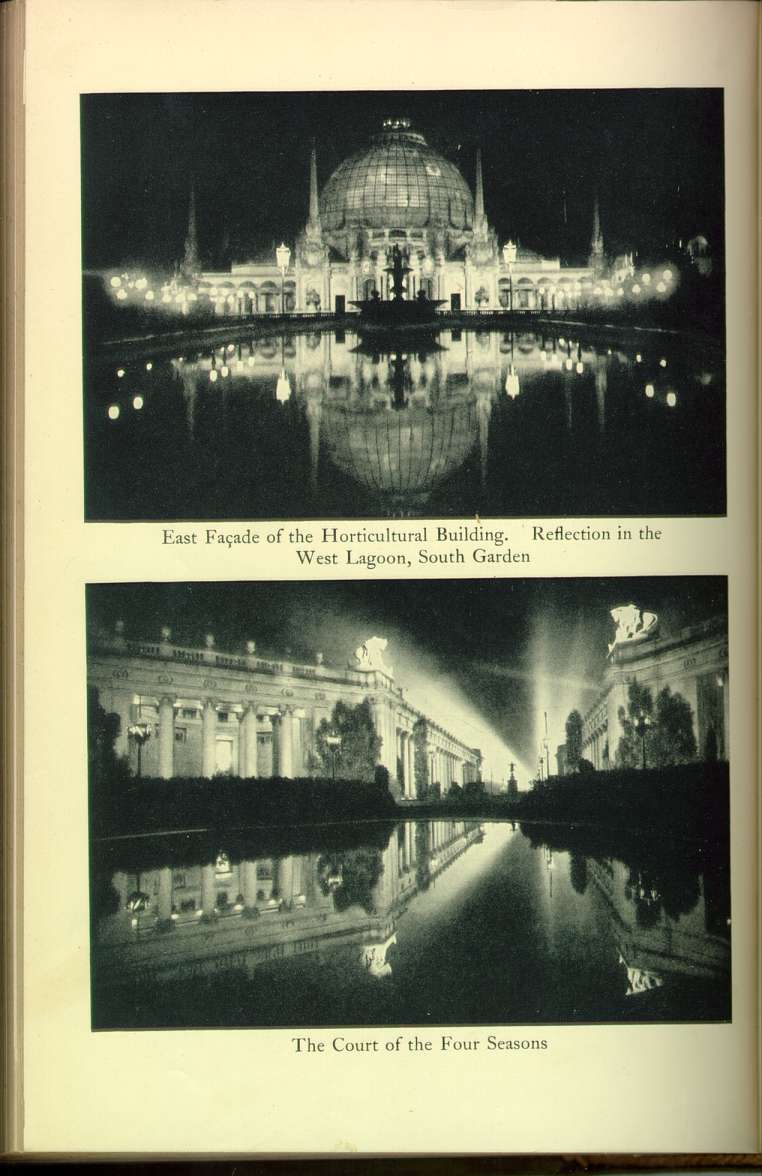
The Court of the Four Seasons
[Description: Another view of the Court of the Four seasons, taken at
night]
Another determining force in shaping the art of a country, which it is impossible to overlook, is the prepossession which its citizens bring to it. The Argonauts of forty-nine brought the spirit of romance, and left us with that joyous disregard of artistry which is the best ground for a new art to spring from. The Franciscan fathers contributed one of our two predominating types of architecture and a style of furniture which gains favor steadily. The Conquistadores bequeathed a little of the romantic manner and a poetizing tendency in names of places. The Japanese and Chinese have done much in their wares to satisfy and foster the Western love of color in decoration, but the artistic consciousness of the Oriental is worn too smooth by centuries to make a dent in the robustious West. They have glanced off at contact, to fall outside the area of immediate production. It has remained for the rejected and downtrodden aboriginal to leave a determining mark. In color, in decoration, and in design the Indian note has struck upward like the thorn through the foot which treads the thorn-bush. It is very noticeable in the Exposition of San Diego; it is shaping by slower and less sensible degrees the forms of verse and drama, it sounds not as an alien strain through the music of the West, but as the plaintive, intimate note of the land itself, the earth cry below the song of the harvest. What one observes at present is a resemblance growing out of something like the aboriginal surrender to the environment rather than any deliberate appropriation of aboriginal motives. Not until this vanishing race attains the full dignity of extinction will its musical themes and decorative units pass into the artistic currency of the West.
But when you reflect that the Greeks began with just these things, great natural beauty, an adventuring, colonizing people such as settled the Sacramento and the San Joaquin, and with a legendary and dramatic representation of man's relation to vast invisible forces, it is possible to believe that people beginning there and on a scale so much more magnificent will be justified in any expectation. Any one going west to look for it must find the index of what the art of the West is to be not in the art palace, but in life as it is lived there, in the mastery of modes of living in which the West suggests its as yet unutterable things.
| Art Influence in the West | ||